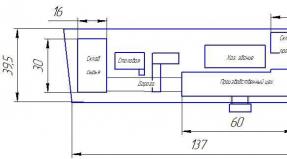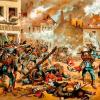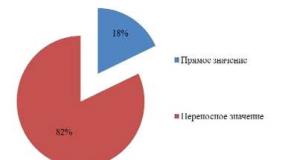How to draw the constellation Leo by dots for a child. Leo constellation in astronomy, astrology and legends. Stars and contour diagram of the constellation Leo
Most constellations are nothing like what their names indicate. In the constellation Pegasus, for example, it is difficult to recognize the legendary winged horse, and in the constellation Lynx - a forest predator.
Another thing is Leo. It only takes a little imagination to find and recognize the king of beasts in the drawing of its brightest stars. The figure of this constellation is so simple and expressive that it is instantly remembered. Therefore, Leo is often used to search for neighboring constellations, which are far from being so expressive.
But how to find the constellation Leo in the starry sky?
First, let's agree when we will look for him. Let's search in the evening, because in the evening it is easier to do this than at night or early in the morning (usually at night we are already sleeping, and in the morning we are in a hurry to study or work).
In the evenings, the constellation Leo can be observed starting in February. At this time, Leo rises in the east just after dusk, and late in the evening is observed in the southeast.
On February evenings, the constellation Leo rises late at night in the east. Pattern: Stellarium
A special sign by which you immediately distinguish Leo from other constellations is great trapezoid of four stars. In size, it is almost equal to the bucket of the Big Dipper, and the brightness of the stars of these two celestial figures is quite comparable. The brightest star in the Trapezium of Leo is in its lower right corner. This Regulus, the main star of the constellation and the twentieth brightest star in the entire night sky.
You don't need any special guidelines to find a trapezoid - it will immediately catch your eye, you just have to look in the right direction! As I said, in February, the trapezoid is visible in the evenings in the east and southeast, but - pay attention! - in an inclined position.

The constellation Leo in the evening sky in March is in the southeast. Pattern: Stellarium
The most convenient time to observe the constellation Leo is Spring especially its first half. In March, at dusk, the constellation Leo appears in the southeast, being quite high in the sky - halfway between the horizon and the zenith.
Even higher, the constellation Leo is observed on April evenings. At this time, it is observed in the south and is the full owner of the spring sky, since the constellations surrounding it are very dim. Only two stars - Arcturus and Spica - are brighter than Regula in the spring sky. But the constellations of these stars - Bootes and Virgo - are rather indistinct. The trapezium of Leo in April is visible in a horizontal position, so finding it in the sky is quite easy.
By the way, if you still doubt that you can independently detect the constellation Leo in the sky, keep a guideline: Leo is under the Big Dipper bucket! With this in mind, you will quickly find the Leo constellation at any time of the day or year, as long as it is above the horizon at that moment.

In spring, the Big Dipper is almost at the zenith, and the constellation Leo is below it in the southern side of the sky. Pattern: Stellarium
It gets dark late in May; the constellation Leo appears in the evenings in the southwest and spends only a few hours in the sky, after which it sets below the horizon.
And here you can ask: why was the constellation Leo named after the king of the beasts, and not just the Trapezium?
When you find the constellation Leo in the sky, take a closer look at it. Above the right edge of the trapezoid, you will probably notice three more stars, which, together with Regulus and the star of Algieba (upper right in the trapezoid), form a figure that looks like a question mark looking the other way. This drawing has long been popularly called the Sickle for its resemblance to an old peasant instrument.

Asterism Sickle Lion. The handle of the sickle is marked by Regulus, and the stars Algieba, Adhafera, Rasalas and Epsilon Leo mark the sickle itself. On ancient maps, the front paws, chest and head of a lying predator were depicted here. Pattern: Stellarium
But also in this figure you can see both the chest and the head of the Lion! It seems that the predator is lying with his head up and looking somewhere in the distance to the west.
By the way, on a dark and transparent night in the sky you can see lion tail. But we'll talk about this stellar drawing later.
Post Views: 16,535
Constellation Leo located in the northern hemisphere of the sky. It is one of the 12 zodiac constellations.
It is usually considered that constellation Leo got its name in honor of the mighty Nemean Lion, killed by Hercules.
In astrology, Leo is considered the masculine extrovert sign.
Constellation Leo best seen in the sky in spring.
Below constellation Leo, on the left, the "head" of the constellation Virgo is visible, and in the right corner - the constellation Sextant. The group of stars between them belongs to the constellation Leo.
The brightest stars constellation Leo:
Regulus (α Leo, Alpha Leo) - 1,36 m - "Heart of the Lion"
Algieba (γ-1 Leo, Gamma Leo) - 2,01 m - "Lion's mane"
Denebola (β Leo, Betta Lion) - 2.14 m - "Lion's tail"
Zosma (δ Leo, Leo Delta) - 2.56 m
Algenubi (ε Leo, Epsilon Leo) - 2.97 m
Chertan or Hort (θ Leo, Leo's Tetta) - 3.33 m
Algieba is a double star - on the map, the names of the two stars of this pair coincided.
The most famous deep sky object in the constellation Leo is the Leo Triplet. The two brightest galaxies from it are indicated in green: M65 and M66. Almost next to them is the third - the galaxy NGC 3628, only slightly inferior to them.
Where these three galaxies are located is the Leo Cluster, a cluster of galaxies that, together with the cluster of galaxies from the constellation Coma Berenices, forms one giant supercluster of galaxies.
A little to the right, another relatively dense group of three galaxies is visible: M95, M96 and M105.
Both of these groups are quite accessible for observation in a telescope not very large (naturally, the larger the telescope, the more details).
If you have a telescope with a good aperture, then you can linger in this part of the sky for a long time, here everything is dotted with less bright galaxies around the Leo Triplet.
This is especially true of the neighboring constellation Virgo - there is the famous Virgo Cluster, a huge cluster of galaxies, part of which is visible on the map above as two galaxies M98 and M99.
If the website removes unnecessary captions on the "online sky map" and turns on the display of faint galaxies, then the sky around the constellation Leo looks like this: 
Here the Leo Cluster is already clearly visible.
How to find the constellation Leo
Constellation Leo best seen from February to March. At this time, around midnight, it passes its highest position in the sky. Accordingly, the Sun is in the constellation Leo from August 10 to September 15.
In central Russia, the constellation Leo does not rise above half the height of the sky.
Finding the constellation Leo is quite simple.  To search for the constellation Leo, mentally extend the line through the indicated two stars of the bucket of the constellation Ursa Major by about two lengths of this "bucket". There you will see a clearly distinguishable figure of several stars - this is the "Sickle" asterism, similar to a question mark, looking to the right. "Sickle" - the most noticeable part of the constellation Leo, this is his head and chest.
To search for the constellation Leo, mentally extend the line through the indicated two stars of the bucket of the constellation Ursa Major by about two lengths of this "bucket". There you will see a clearly distinguishable figure of several stars - this is the "Sickle" asterism, similar to a question mark, looking to the right. "Sickle" - the most noticeable part of the constellation Leo, this is his head and chest.
The "point" of this imaginary question mark is Regulus, the brightest star in the constellation Leo.
All six stars of the Crescent asterism are quite bright and clearly visible in the sky.
Constellation Leo - interesting facts
Constellation Leo stood out in the sky even by the ancient Sumerians, 5000 years before our era. The ancient Sumerians called him "Big Dog". The constellation Leo was distinguished in the sky and the Indians on the American continent.
In the constellation Leo is the center (radiant) of the Leonid meteor shower associated with comet 55P/Tempel-Tuttle. Its strength varies from year to year. The flow is observed from 14 to 21 November each year.
In November 1833, the density of the Leonid meteor shower, observed in North America, reached such strength that preachers predicted the end of the world. Eyewitnesses described it like this:
“A storm of shooting stars hit the Earth [...] the sky in every direction was filled with luminous trails and illuminated by majestic fireballs. In Boston, the meteor frequency was estimated to be about half that of a snow flake in a moderate storm."
This event was reflected in the lyrics of pop singers and in folk art.
In the constellation Leo, there is approximately the fifth star from the Sun - Wolf 359. This is a very faint red dwarf - its brightness is only 13.53 m Distance - 2.39 pc or 7.78 light years.
or tell your friends:Leo is a very important constellation, which is the main figure of the night spring sky. It serves as the basis for amateur astronomers to search for other constellations. The Leo constellation is very rich in various interesting objects that are very easy to see with a small telescope and even with the naked eye. It can be observed from February to March in the southern part of the night sky.


- is the most important object of the constellation Leo. It is located almost in the center of the constellation and is often associated with the heart. This is the brightest star, the brightness of which is 160 times higher than that of our Sun. This star is located 85 light-years away, which explains its high apparent brightness.
Modeling Regulus Rotation
Denebola- the second brightest object that belongs to Leo. This is the extreme star, which is often referred to as the tail.
Algeiba- a double star, one of the most beautiful in the sky. Denotes a majestic mane. If you look closely, the slightly orange star has a noticeable golden companion. The orbital period of this binary system is approximately 510 years.

There are several more and even triple stars in the constellation, which are worth paying attention to. These are stars called 54 and 88 Leo (double), and 90 Leo (triple). If you look closely at the star 90 Leo, you can see two bright blue dots with a distinct companion at a short distance from them.
variable stars

Also present in Leo. It is worth paying attention to Leo's R variable - one of the long-known variables. Its brightness varies from 10 to 5 magnitudes. It is very interesting to find this star during the period of minimum luminosity and observe its “flare up”, which lasts 312.5 days.
A very interesting object is located in the very depths of the constellation. This is Wolf 359 - a red dwarf, which is located only 7 from us. Due to its low brightness, this star is only visible through telescopes.

Orange Wolf 359 in the center of the picture
galaxies

In a 7-8 cm telescope, you can see not only stars, but also entire galaxies. So, if you look closely at the constellation Leo, you can easily find the "Trio of Leo", namely the galaxies NGC 3628, M 65 and M 66. M 66 is the largest galaxy of this trio. It is located at a distance of 35 million light years. It has a clearly defined core and arms that are shifted upward relative to the plane of the galaxy. It is assumed that such an effect was formed due to the gravitational influence near two nearby neighboring galaxies. If you take a more powerful telescope, you can see and consider the structure of M95, M96, M105, NGC 2903.
asterisms

In the constellation Leo, there is an asterism called the Sickle. It consists of six stars. Namely, α, η, γ, ζ, μ, and ε. The shape of this asterism resembles exactly a sickle, or a question mark. The point of this question mark is the brightest star of this constellation - Regulus.
Story

The constellation Leo has been known for several thousand years. The name, oddly enough, it also acquired immediately, which is still used today. Assyrians, Babylonians, Hindus, Persians and Jews - all saw this constellation and called it in honor of the king of beasts.
| List of constellations in the spring sky | |
|---|---|
| · · · | |
In the night sky, even with the naked eye, you can see the constellation Leo. The Great and Lesser Leo, located nearby, have long been the subject of study by astronomers, in no way inferior in this sense to other constellations. Where and when can they be seen in the sky? What luminaries are included in these constellations? This is what we will try to find out further.
Both constellations are in the Northern Hemisphere. Of these, of course, the Big Lion is more famous. Its prototype was the one with which the hero of Greek mythology Heracles fought desperately. Lesser Leo is located between Ursa Major and Leo. The close proximity of these constellations in the night sky does not give reason to consider them under the general name "Constellation of Lions". Most often they are mentioned separately.
And not in vain. After all, the Big Lion has much more reasons to boast. His Regulus (translated from Latin as “king”) is 160 times brighter than our Sun and about 3 times larger than it. Other brightest stars in the constellation Leo are Denebola, Algieba, Zosma and Algenubi.
It is located next to such constellations as Virgo, Cancer, Sextant, Cups. In total, there are about 70 stars in its composition, but most of them are faintly visible.
The shape of the constellation is similar to an irregular hexagon, on one side of which there is a curl in the form of an inverted question mark. This curl is the supposed mane of the lion, and its six stars form the well-known asterism Sickle.
There are a lot of interesting objects in the constellation Leo: galaxies, binary and variable stars, which can only be seen with a powerful telescope.
The constellation is best seen in February and March, and in mid-November, you can also observe the Leonid meteor shower, which peaks on November 17th.
Constellation Leo Minor
Lesser Leo is a very small constellation that contains 34 stars. It is best viewed in spring and summer. not as remarkable as his older brother. No interesting objects are observed in it, and its brightest stars do not form a clear geometric figure.
The discovery of the Small Lion was made by Jan Hevelius in 1610. He was the first to place the constellation in his atlas "Uranography". Later, astronomer Francis Bailey, pointing out the bright stars of the Lesser Lion, noted only the second brightest, completely forgetting about the first.

Conclusion
The constellation Leo is two constellations located side by side. In the Northern Hemisphere, they can almost always be seen, although they are especially well visible in the spring. On celestial atlases, astronomers placed them side by side, since it was believed that the Small Lion should be similar in its influence to the Big Lion.



















